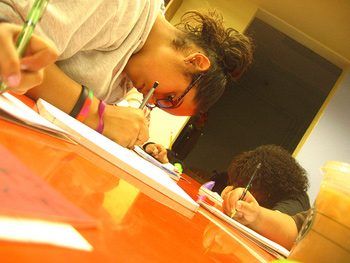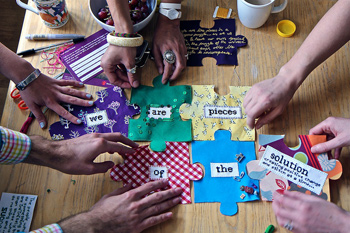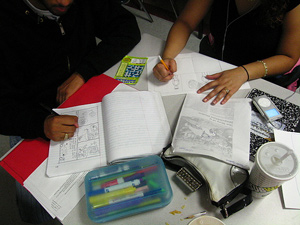
Source: Writers club, Brande Jackson, Flickr
Now that you have a narrowly focused central idea, it is time to begin writing. As you know, a personal narrative is a story. It has a beginning (the introduction), middle (the body), and end (the conclusion). Moreover, a personal narrative is a story written in first person, so you will be using pronouns such as I, my, mine, and we to tell your story.
Let’s discuss the introduction of your personal narrative next. A good introduction must
- grab the reader’s attention;
- introduce the reader to your central idea (without all the supporting details); and
- set the tone of the piece.
The Hook
To grab the reader’s attention means to provide the reader with motivation to continue reading. This is called a hook.
You can hook the reader in several ways, but for a hook to be effective, it must relate to your central idea while setting the tone—funny, sentimental, tragic, etc.—of the writing to come. Here are a few techniques for a hook that you might try.
You can use some of the devices below to hook your reader. (The examples following the devices use the central idea of our model narrative, “The adventure Danny and I had in the dead of winter means a lot to me now because it shows me what it means to have a best friend.”)

Source: Dark clouds, C.E. Price, Wikimedia
- Foreshadowing, a forewarning given to the reader of something
that may occur later
The day we took off for the woods the sky was already filling up with dark clouds.

Source: Easiest Route, Evhead, Flickr
- Dialogue, or conversations between characters
“Hey!” he yelled over to me. “How come you never want to take the easy route?”
“What for?” I yelled back. “Never have any fun that way!”

Source: Sayville Station from Railroad Avenue Xing, Dan TD, Wikimedia
- Setting and/or character description, a detailed description
of what, who, and/or where
The frozen railroad tracks stretched out for miles before us.
Danny looked like a giant, happy, marshmallow all dressed up in his big white snowsuit, smiling from ear to ear.

Source: Aaargh! Stampede!, Mo Morgan, Flickr
- Action, a detailed description of what is happening
We reached the edge of the field when all of a sudden we heard the thundering of a million hooves behind us. The entire herd was chasing us!
 Using your notes, write a hook for your personal narrative.
Using your notes, write a hook for your personal narrative. Once you have the hook nailed down, you can continue crafting a draft of your introduction by including some interesting details about your story. Refer to the notes that you wrote about your narrative
in the previous two sections. What you want to keep in mind is that your readers will find it much more engaging if you show rather than just tell details. What’s the distinction? Telling the reader about an event means simply stating the details without much description. Showing the reader something means you add interesting details that involve the senses of hearing, seeing, feeling, touching, smelling, and tasting.
Telling: The snow was falling hard in the woods that day.
Showing: The snow fell soft as feathers, but hard enough to blanket our heavy snowsuits in seconds, making us look like a couple of Frosty the Snowmen, tramping through the woods.
The Body

Source: #imavist Craftivist Jigsaw Project, craftivist collective, Flickr
In the body of your personal narrative, you tell your whole story. The length of your narrative—how many body paragraphs you write—may depend on the number of events you choose to include in your narrative. The way you can determine this is by deciding to focus on the events that best convey to your readers the central idea of your story.
You can organize the events that you wrote about in chronological order (writing about what happened in the order it happened), but you don’t have to take this approach. You can also use flashbacks, or you can start at the end of the story and work backward to the beginning. There are many ways to organize your narrative depending on what you want to say. Keep in mind that this story is a personal account of something that happened to you, so you can include reflections about the decisions and actions that were taken in response to events, as well as how you feel about what happened.
The events that occurred and your personal reflections on those events (the central idea of your narrative) are the elements that you need to focus on throughout your piece. If you recall, in our model narrative, our narrowly focused central idea has to do with how certain events that happened during a winter adventure cemented a strong bond between two friends.
 Think for a minute about all of the action that’s in the story. What are some of the action verbs that you read? Use your notes to list a few of the many words in the body of the narrative that show action. As you write your narrative, remember that you have to “show” not “tell” your readers. The writer of this narrative knew that he had to use action words to get readers to understand how dangerous the situation was. It was as if you were there with the boys as they tried to make their way home through the snowy wilderness. As you write your narrative, think about all the action words you can use to make your readers think they are sharing the events with you.
Think for a minute about all of the action that’s in the story. What are some of the action verbs that you read? Use your notes to list a few of the many words in the body of the narrative that show action. As you write your narrative, remember that you have to “show” not “tell” your readers. The writer of this narrative knew that he had to use action words to get readers to understand how dangerous the situation was. It was as if you were there with the boys as they tried to make their way home through the snowy wilderness. As you write your narrative, think about all the action words you can use to make your readers think they are sharing the events with you. Sample Responses:
trudged, screamed, swept, throwing, knocked, raging, jampacked, gushing

Source: Word Wall Panel Fresh From The WaterJet - “think” Closeup, v8media, Flickr
Remember that your tone is important. The tone is how you want your readers to feel while reading your story. Your choice of words signals the reader about the tone of your story. For example, you can choose descriptive words to suggest a tone of happiness or sadness or anger, but think carefully about your word choice to make sure that readers will understand the tone. See Write Literary Text That Uses Literary Strategies/Devices to Enhance the Style and Tone in the Related Resources for a more in-depth discussion of tone.

Source: Focus and Determination, cityyear, Flickr
Of course, you may want to adjust the tone of your story depending on the events taking place. For example, although the general tone of your story may be happy and humorous, you may need to change the tone in one part to serious and thoughtful in order to show the reader how a negative turn of events eventually resulted in personal growth.
 Using your notes, write a draft of the body of your narrative.Tip: Use the tone you established in your introductory hook and support your central idea with reflections that show (and don’t simply tell) your readers what happened. Also, show how you felt or feel about the actions, decisions, and consequences resulting from the various events of your story. When you are finished writing the body of your story, check your understanding to read the body of the model narrative. Note: Your personal narrative might not be this long as our response, or it might be longer, depending on the events in your narrative.
Using your notes, write a draft of the body of your narrative.Tip: Use the tone you established in your introductory hook and support your central idea with reflections that show (and don’t simply tell) your readers what happened. Also, show how you felt or feel about the actions, decisions, and consequences resulting from the various events of your story. When you are finished writing the body of your story, check your understanding to read the body of the model narrative. Note: Your personal narrative might not be this long as our response, or it might be longer, depending on the events in your narrative.Sample Response:
By the time the last sandwich disappeared from our packs, we realized it was beginning to get late. We needed to find the railroad tracks soon. So putting the cow incident aside as best we could, we began the journey homeward.
As we trudged through knee-deep drifts of newly fallen snow we came upon a path. It ran from the field through which we were walking to a nearby patch of woods. We had no idea where we were. Taking this path, we realized, could either get us home, or get us hopelessly lost. It was getting colder by the minute, so we decided to take a chance; we took the path.
At first the path seemed easy and well marked, but the farther we hiked, the denser the forest became until suddenly the lights went out, the path ended, and we were lost! From our Boy Scout training we remembered that the best thing to do when you were lost was to remain calm and think. We screamed wildly . . . then we stopped . . . and screamed wildly again. Looking back on it, I think maybe we shouldn’t have gone so far in the first place. Things were turning downright dangerous. Little did I know just how dangerous.
Danny and I were frantic. Standing shoulder to shoulder in the woods, in the middle of nowhere, not knowing which path would lead us homeward, we realized we were hopelessly lost. It was getting late; daylight filtered weakly through the boughs of the pine trees above our heads. Would we ever find our way back home? We could feel the late afternoon air getting colder, freezing the tips of our noses and toes.
After tramping through the snow for what seemed like hours, we finally broke out of the dense pine forest, right across from old Black Brook Road! We let out a whoop of delight! But now we had a bigger problem. Between the road and the edge of the woods where we were standing, there was a raging creek, jam-packed with frozen chunks of ice and tree limbs, all moving at about a million miles an hour! Being wider than either of us could jump and gushing so fast that we probably wouldn’t have the guts to try anyway, the river was a huge obstacle. We decided on another strategy; we would build a bridge.
So gathering what we could in the way of materials, dead tree limbs, and small saplings, we set upon the task of bridging the creek. It didn’t take long before we had enough limbs laid over the creek to try going across. Looking back on it I’m not exactly sure how this job fell to Danny. Maybe we drew straws, or maybe we played a quick game of rocks and scissors. But regardless of the method, it turned out to be a very important decision. Because no sooner had Dan placed his foot on the first limb then the force of the rushing water knocked it aside, throwing Danny straight up into the air before splashing full force into the icy water! Danny was suddenly being swept downstream! It happened so quickly and with such violence that I found myself frozen in my tracks.
Something automatic took over because, before I knew what was happening, I was running along the side of the creek bed trying to keep up with him. Danny was being tumbled along with huge chunks of ice, broken limbs, and rocks. I ran as fast as I could, dodging bushes and trees as I went. I tried desperately to figure a way out of this horrible nightmare. How am I going to save my Danny? Jumbled, disconnected thoughts swirled around in my mind like the murky brown water I was racing next to. “I’m only 10,” I thought. “I couldn’t possibly be in this serious a situation. It can’t be real. It just can’t be!” Then I saw it. Out of the corner of my eye . . . a BRIDGE! A REAL BRIDGE!
It was only a short distance away, so in order to get there before the current swept Danny beyond it, I would have to hurry. I sprinted to the bridge ahead of Dan, dodging shrubs and heavy branches as I ran. I scrambled under the bridge and wedged my body up into the trusses, bracing myself for when Danny came bobbing by underneath me. As the water swept him by me, I shot my arms out to grab him. Our outstretched arms linked, and I struggled to keep hold of him. The force of the rushing water nearly pulled me into the stream, but I was able to hold on just long enough to get a better grip. Slowly, I pulled his soaking wet body up out of the water and onto the bridge. He was safe! That’s when I knew we’d be best friends forever.
The Conclusion

Source: IMG_0787, Runs With Scissors, Flickr
Your personal narrative is all about you. So when you write your concluding paragraph, you can use any literary elements (e.g., irony, alliteration, metaphor, simile, personification, imagery) that you think will most appropriately provide your reader with a strong sense of how your event or experience changed you. Did it give you important insights into who you are or about life in general?
You might use a simile, for example, to compare your new realization to a different situation involving different people or events. Did the event change your attitude or give you a different perspective? A detailed description of a tranquil pool or a rough mountainous terrain (imagery) might add just the right touch to help your reader understand your new perspective. The idea is to leave your readers with a clear sense of closure and completion.